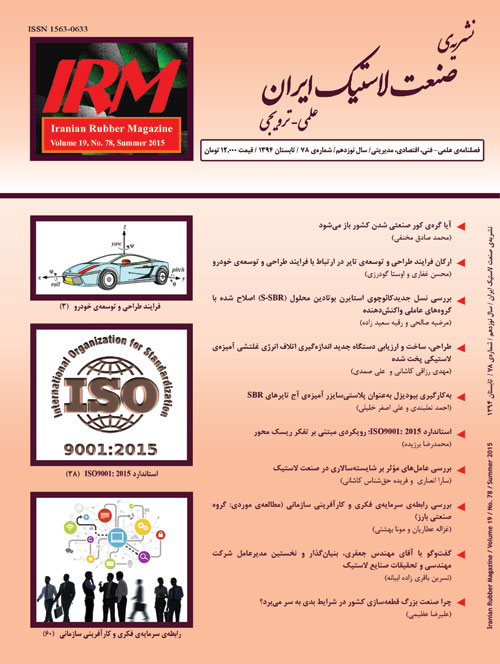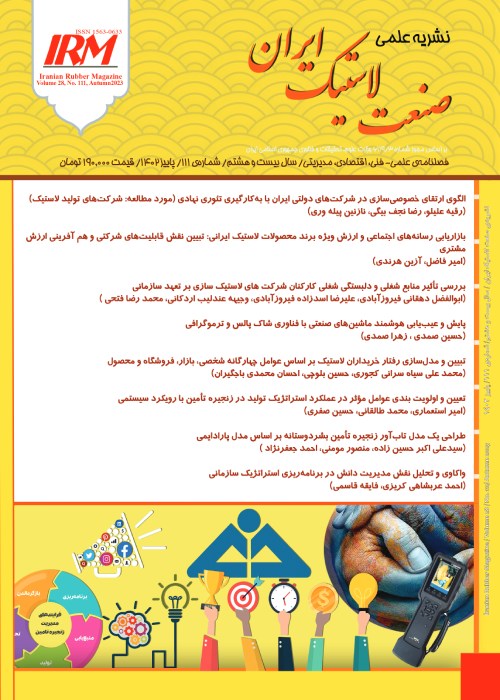فهرست مطالب

نشریه صنعت لاستیک ایران
پیاپی 78 (تابستان 1394)
- تاریخ انتشار: 1394/08/13
- تعداد عناوین: 10
-
- سرمقاله
- علمی فنی
- مدیریت کیفیت
- مدیریت
-
بررسی رابطه سرمایه فکری و کارآفرینی سازمانی / مطالعه موردی: گروه صنعتی بارزصفحه 60
- گفت و گو
- گزارش
-
Page 4In this paper we will explain the complete tire improvement process topics based on a specific vehicle characteristics. Also we will study the tire role in this process as a part of vehicle suspension and also as an independent item. We know that tire is the only part to contact between vehicle and track and will conduct all the forces between them. Then will affect the vehicle dynamic behavior clearly. The process contain vehicle performance test, measuring the tire characteristics, clearly set the improvement goals and then execute the tire design changes. Then again vehicle test in proving ground to verification the tire performance. Also we will explain about a case study we done based on explained method.Keywords: Tire Handling, Tire Characteristics, Performance test, Vehicle Dynamic, Tire mechanics
-
Page 9For the improvement of both rubber-silica interaction and as result rubber properties such as abrasion, high dispersible Silica and modified S- SBR have been applied. In this research, the green tire tread properties based on the latest generation of S-SBR were investigated.Keywords: Green tire, S, SBR, Loss properties, Tire tread, Silica
-
Page 15A practical method to measure the energy dissipation in rubber vulcanization under rolling condition has been considered. For this purpose, a modified rolling pendulum device was designed and constructed to eliminate the shortcomings of an initial design by Gent. This modified device has a working table, heated rolling plate, symmetric pendulum, and ultrasonic sensor for accurate measurement of the roller traveled distance and calculation of rolling resistance parameters for rubber. Performance of this new device was evaluated by measurement of the rolling resistance force and coefficient for rubber vulcanization containing un-modified and Silane- modified nano-Silica under different conditions. The device could successfully show the effects of strain, temperature, and silica surface modification on rubber rolling resistance parameters, as reported by other researchers.Keywords: Rolling energy dissipation, Rubber vulcanization, Nano Silica, Viscoelastic behavior
-
Page 22The solubility parameter of a group of methyl esters of fatty acids, the main components of biodiesel, was calculated using the group incremental method proposed by Van Krevelen. The solubility parameter of biodiesel was compared with that of a series of rubbers like EPDM, butyl rubber, polyisoprene, polybutadiene, SBR (with different content of styrene) and nitrile rubber (with different content of acrylonitrile) and it was shown that biodiesel is an effective solvent for all the above rubbers, except nitrile rubber. The solubility experiments being carried out manifest Polyisoprene; Polybutadiene and SBR are easily soluble in biodiesel, while Polystyrene is not, gives a cloudy solution. Considering on the solubility parameter of biodiesel and those of the above rubbers, it was concluded that biodiesel is able to behave as an internal lubricant in the matrix of diene rubbers. The same situation occurs with the common aromatic mineral oil plasticizer known as T-RAE. The experimental evaluation of biodiesel used as plasticizer in an SBR based rubber compound have led to the conclusion that biodiesel is reactive with the sulphur curing agents,subtracting Sulphur to the crosslinking Polymer chains and leading to vulcanizate with lower moduli, tensile and hardness and higher elongation in comparison to reference compound fully plasticized with an aromatic mineral oil. Moreover, it is expected that biodiesel to be a good low temperature plasticizer because the low elastic modulus observed is desired in a winter tire tread for a good grip on snow and ice. The present work is only an exploratory work, and the tire tread formulation with biodiesel was not optimized.Keywords: Plasticizer, plasticizers, biodiesel, fatty acid esters, rubber formulations
-
Page 38Deployment of Management systems have been consider by so many organization worldwide since the publication of the first series of ISO9000 standards in 1987. This approach has been affected the Iranian organization at least in past 15 years. So more than 9,000 valid ISO9001 certificate has been issued in Iran at the end of 2011. In this years the changes that happened in organizational culture due to introduction of management system deployment was very tangible.so in recent years, so many of traditional managers changes theirattitude to organization and management system, and trying to use of advantages that provided by this systems. According to this fact, following the implications of this standards is undeniable necessity and creation of any changes them will certainly affected any organizations that use of this standards. ISO 9001 standard as the general standard that used for any type of organization (manufacturing, services, marketing, etc.) has been revised to improve the concepts at the different period times. Here we focus on mechanism of modification of standards in ISO organization include the brief explanation of various stages for developing /revising the standards and briefly discussed about main changes that occur for new revision of ISO9001 9(according to FDIS).Keywords: ISO, Technical Committee, Context of organization, Risk
-
Page 47The objective of this study is to examine effective attributes in meritocracy as practiced in Iran rubber industry. Meritocracy is defined as the continual process of assigning employees to the right jobs, periodic work assessment, and job reinstatement or reassignment based on the assessment outcomes. This study examines three attributes of meritocracy, namely, merit selection, merit development, and merit retention, as applied in rubber industry. A sample size of 335 was decided for this study by applying sampling size formula for limited population. Study methodological was applied survey based on descriptive method. Study data was collected by a researcher made questionnaire. Data collection was performed based on indexes of a conceptual model. Consistency reliability of the study was calculated and confirmed by Cronbach’s Alpha. The quantitative findings of this research obtained from statistical software confirmed study hypotheses and the proposed model. The study findings showed significant relations between meritocracy attributes. Therefore, the selected attributes clearly explained the state of meritocracy in rubber industry.Keywords: Meritocracy, Merit selection, Merit development, Merit assignment, Merit retention, Merit
-
Page 60In recent decades, entrepreneurship has become a topic of interest to researchers. The study of the factors affecting organizational entrepreneurship, intellectual capital has been paid to the agent. In order to achieve the objective of this study was to investigate the relationship between intellectual capital & organizational entrepreneurship,we used Bontis`s view about intellectual capital. The data obtained from the 143 questionnaires that content validity from 30 experts & managers of Barez industrial group. Their reliability by Cronbach`s alpha coefficient of 0.88 was approved by Spss software were analyzed. Due to the non-normality of the data was confirmed,the Spearman`s correlation coefficient was used for the statistical analysis. The results was showed a significant positive relationship between intellectual capital & organizational entrepreneurship aspects for workers of Barez industrial groups. This means that the investment in intellectual capital of the organization in the human dimension, structural & customer capital can be expected to improve organizational entrepreneurship.Keywords: Intellectual capital, Organizational entrepreneurship, Human capital, Structural capital, Customer capital


